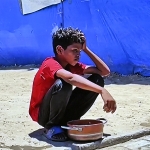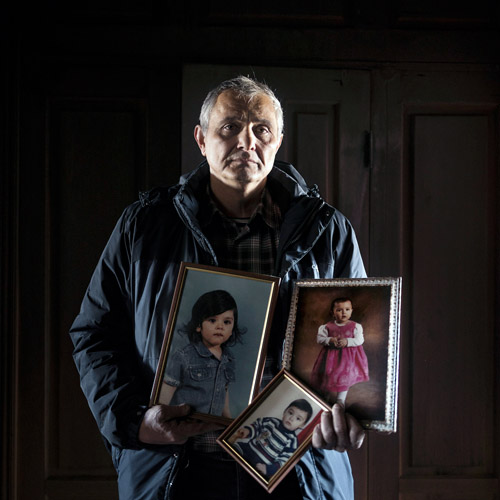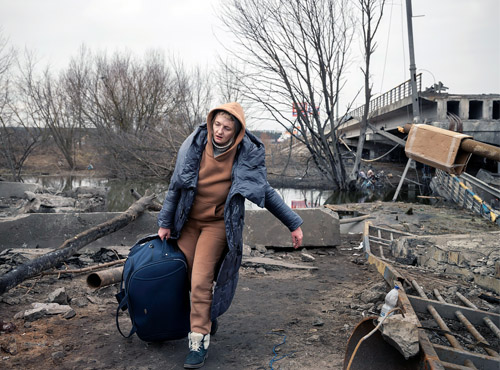Magnum - A Year in Ukraine
All through this criminal, brutal and unjust Ukraine War I have tried to sustain a series of images from the conflict through stills from TV video footage (viewed in the site gallery). The aim is to alert any Russians viewing the site of the true horror and criminality being inflicted by Putin on the Ukrainian people who, due to heavy media censorship and stifling internal laws are blissfully unaware of the situation. They would also being unaware of the thousands of young Russians who are being sacrificed at Putin’s alter every day the conflict continues.
I have long been an admirer of Magnum agency photographers who continue to inspire me and whenever the opportunity arises I will feature some of their work. At this first anniversary of Putin’s war I offer a view of the conflict seen through the eyes of Magnum photographers, all of which and many more are available through Magnum.
https://www.magnumphotos.com/shop/
A woman evacuating from Irpin, March 7, 2022 © Jérôme Sessini/Magnum Photos.
In war, a frontline is not just a battlefield. It can provide a certain degree of security or predictability; a measurement demarking the line of conflict, to be defended by opposing forces, and avoided by almost all others. However, the reality of modern conflict is that the line of separation is ever-changing, or may not exist at all.
Speaking ahead of the one-year anniversary of the invasion of Ukraine on February 24, a recurring theme emerged in my conversations with some of the 16 Magnum photographers who have visited the region this past year - the unpredictability of constant danger.
Russia’s assault by land, air and sea has devastated any semblance of safety. Violence can be very sudden and very extreme, leaving civilians vulnerable to attack at any time. The camera has only one function in moments of fear - to freeze them.
As the fighting rages on, civilians escape from Irpin under Russian army mortar shelling. At least three civilians were killed during the evacuation. March 6, 2022 © Jérôme Sessini/Magnum Photos.
One image that captures the raw emotion of civilians caught in the crossfire is Jérôme Sessini’s photograph of a family fleeing Irpin, one of the towns northwest of Kyiv, where Russian forces launched several attacks in their unsuccessful advance on the capital during the first weeks of the invasion.
Sessini’s photograph captures a terrifying moment during the evacuation, as fighting rages on and civilian’s attempt to flee as Russian mortars rain down. The family falls to the ground, their expressions contorted with fear and desperation. The camera angle is low, at the same level as the family, drawing us into the scene.
Destruction near the Kharkiv Regional Palace. March 16, 2022 © Jérôme Sessini/Magnum Photos.
“Getting to the frontline wasn’t my priority. I like to stay at the human level.”
Residential buildings in the city center destroyed by fighting and Russian missile fire. Borodyanka, April 9, 2022 © Jérôme Sessini/Magnum Photos.
Sessini’s photograph may be less overtly gruesome than many of the images of death and destruction that we’ve since witnessed from photographs of liberated towns, yet it is difficult to remain unaffected by the sight of a helpless child in the grip of terror.
He arrived in Ukraine last March on assignment for The New Yorker. The magazine assisted the photographer by providing a security advisor for the last two weeks of his trip.
“The Russians were bombing the capital and there was nowhere to escape. [The New Yorker] asked me to stay in a hotel with a basement, in protective attire.” The intensity of the conflict has made it a challenging assignment, even for more experienced photographers like Sessini, who has covered the fighting in Donbas in eastern Ukraine since 2014, not to mention his reportage of conflicts in places such as Iraq, Syria and Libya.
The Barabashova Kharkiv market, is the biggest market in Ukraine. It has gone up in flames after being shelled by the Russian artillery. Kharkiv, March 17, 2022 © Jérôme Sessini/Magnum Photos.
Back in 2014, when the Russo-Ukrainian War really began, following the invasion of Crimea and moves by Russian-backed separatists in the Donbas, there were a lot of restrictions on photographers, and security concerns made it difficult for journalists to access the frontlines. Many left as a result. But Sessini was one of the photographers who stayed, along with his Magnum colleague Larry Towell, attempting instead to get closer to the people caught up in the aftermath.
“Getting to the frontline wasn’t my priority,” Sessini says. “I like to stay at the human level. I photograph the people affected. I want to ask, ‘What are they suffering for?’”
For many at Magnum (and many others also), this is what distinguishes them from news photographers. It’s a common impulse to stay behind after the news agenda has moved on and the international media has departed; to delve into the stories of the people left behind. Most often, these stories are told as long-term projects pursued independently, or shot off the back of assignments.
|
|

|

The Joy Formidable |
LATEST GALLERY IMAGES

The Peace Dividend? 
Crime Scenes |
|
|








